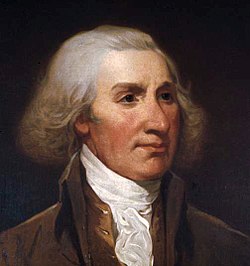1789 United States Senate elections in New York
| |||||||||||
| |||||||||||
| |||||||||||
The 1789 United States Senate election in New York was held in July 1789 to elect two
Background
The
Legislation
In February and March 1789, the
On June 4, Governor George Clinton called an extra session[2] of the State Legislature to convene on July 6 at City Hall in Albany, New York. At the state election in April 1789, for a term beginning on July 1, a large Federalist majority had been elected to the New York State Assembly (65 members), estimated by State Senator James Duane at 42 to 22. The New York State Senate (24 members) continued with a slim Federalist majority.
The 13th New York State Legislature (term 1789–90) convened on July 6, and on July 11 passed "An act directing the manner of electing Senators to represent this State in the Senate of the United States", which required the election to be made by "concurrent vote" of both houses of the Legislature. This meant, if only one U.S. senator was to be elected, that each house nominated a candidate, and if both houses nominated the same person ("concurred"), the nominee was elected. If the Assembly nominated one, the Senate another, then the Senate's nominee was voted upon in the Assembly and the Assembly's nominee in the Senate; if none of the nominees was accepted by the other house, the proceedings started at the beginning. If two U.S. senators were to be elected, and Assembly and Senate chose different nominees, then the Assembly should elect one of the two Senate nominees, and the Senate one of the two Assembly nominees, effectively leaving one seat to be filled by each house of the Legislature.[3]
On July 13, the law was submitted to the Council of Revision. On July 15, the Council objected to the law in two points:
- The Council argued that the choice of U.S. senators by the State Legislature, under the U.S. Constitution, did not require a state law, since the State Legislature does not act in its legislative capacity, and the U.S. senators may be chosen simply by concurrent resolution. On the other side, if the U.S. senators were appointed by a state law passed by the State Legislature, the Council of Revision could object to the appointees, forcing to demand a two-thirds majority to overcome the Council's veto.
- The Council also took exception to the splitting of the seats in the case of two vacancies which would lead to one or both of the U.S. senators being elected contrary to the wishes of one or both of the houses of the State Legislature.
Thus the law was vetoed, and the State Legislature was left to fill the seats without written rules. In practice, the Assembly and the Senate separately took a vote, and if the winner in both houses was the same, he was declared elected. If Assembly and Senate chose different persons, the houses met for a joint ballot, which occurred for the first time in 1802.
Election and aftermath
On July 16, after the Council of Revision had vetoed the law, State Senator
Notes
- ^ Until 1822, the legislative term began and ended in the middle of the year.
- ^ At this time, the regular session of members elected in April began on the second Tuesday in January of the next calendar year; this Legislature met again on January 13, 1790 at New York City.
- ^ This is different from a "joint ballot" election in which a majority of the jointly assembled houses of Legislature elect somebody. In a joint ballot, a large Assembly majority could easily outvote the senators.
- ^ Congress was in session from January 4 to August 12, the State Legislature from January 13 to April 6, 1790.
- ^ There was actually a precedent: In March 1781, Ephraim Paine, then a member of the Council of Appointments, was expelled from the State Senate, and soon after State Senator Arthur Parks was elected by the Assembly to serve the remainder of Paine's term in the Council. All members, Parks included, protested formally, but Parks remained in the Council until the end of the term. However, this precedent was not mentioned during the proceedings in 1790.
Sources
- The New York Civil List compiled in 1858 (see: pg. 113 for state senators 1788–89; pg. 114 for state senators 1789–90; page 164 for Members of Assembly 1788–89; pg. 165 for Members of Assembly 1789–90)
- The Documentary History of the First Federal elections 1788–1790 Vol. 3, by Gordon DenBoer (pages 514ff)
- The First United States Congress
- History of Political Parties in the State of New-York by Jabez Delano Hammond (pages 43f)


